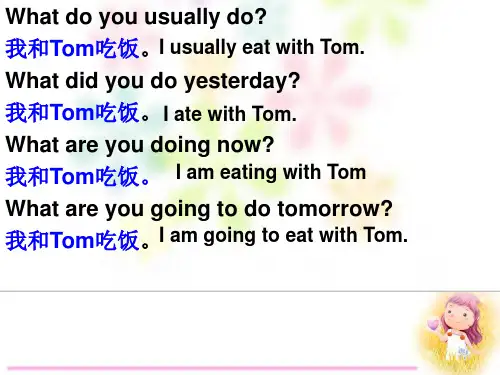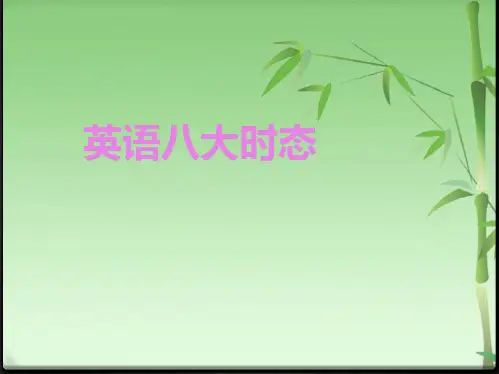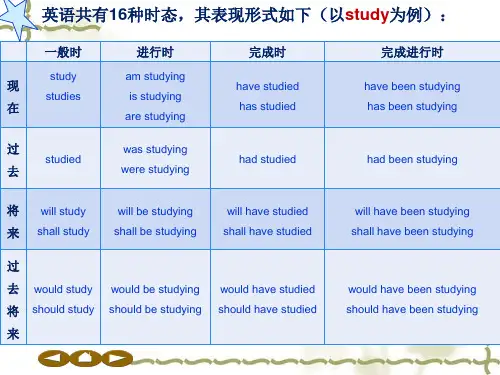专插本英语---英语时态PPT课件
合集下载
英语动词时态语态ppt课件

4.一般将来时、过去将来时==》会 将(讲未来) 发生在将来、发生did的将来 5.现在/过去/将来进行时=》正在 某个点上正在做的事情/强烈的感情色彩 6.过去完成时==》之前/之前已经(过去的过去) 发生在did之前的事情 7.现在完成进行时/过去完成进行时==》一直 一直做一直做一直做做到已经做了很长时间还在做
严格执行突发事件上报制度、校外活 动报批 制度等 相关规 章制度 。做到 及时发 现、制 止、汇 报并处 理各类 违纪行 为或突 发事件 。
二、一般过去时 ( The Simple Past Tense )
1. 结构: 谓动用动词过去式 (V-ed)
2. 用法: 在过去时间里所发生的动作或存 在的状态。常与表示过去时间的时间状 语连用。如 yesterday, last week, an hour ago, in 1982等。
I sleep at noon.
I go to school to school at seven o’clock. Building a high-rise begins with mounds (堆)of soil.
合抱之木,生于毫末;九层之台,起于累土;千里之行,始于足下。
Science has no borders but scientists have motherland What does your mother do?
thousand miles across this open
sea, which
(call)the
Pacific, and we met no storms.
2. He
(do) all the
cooking for his family, but
recently he has been too busy
严格执行突发事件上报制度、校外活 动报批 制度等 相关规 章制度 。做到 及时发 现、制 止、汇 报并处 理各类 违纪行 为或突 发事件 。
二、一般过去时 ( The Simple Past Tense )
1. 结构: 谓动用动词过去式 (V-ed)
2. 用法: 在过去时间里所发生的动作或存 在的状态。常与表示过去时间的时间状 语连用。如 yesterday, last week, an hour ago, in 1982等。
I sleep at noon.
I go to school to school at seven o’clock. Building a high-rise begins with mounds (堆)of soil.
合抱之木,生于毫末;九层之台,起于累土;千里之行,始于足下。
Science has no borders but scientists have motherland What does your mother do?
thousand miles across this open
sea, which
(call)the
Pacific, and we met no storms.
2. He
(do) all the
cooking for his family, but
recently he has been too busy
英语时态8种基本时态讲解.ppt课件

4)动词过去式变化规则。 a)一般情况下的词加-ed. work---worked call----called b)以不发音的字母e结尾的单词直接加-d . live----lived change----changed smoke----smoked die----died graduate----graduated drive----drove
8.过去完成时 表示动作发生在过去某一时间之前已经完成的动作或状态, 强调“过去的过去”, 常与 by the time, by the end of…,before , by 等引导时间的状语连用。
基本结构 主语+ had + 动词过去分词 + 其他成分 When I got to the cinema yesterday the film had begun already. He had learned English before he came here.
现在完成时与一般过去时的区别: 1)现在完成时侧重于对现在的影响;而一般过去时侧重于某一动作发生在过去某个时间或某段时间。即现在完成时侧重于现在的结果,而一般过去时侧重于动作发生的时间。例如:
I have seen the film. 我看过这部电影。(现在我仍记得电影的内容) I saw the film three days ago. 三天前我看了这部电影。(强调是三天前,而不是别的什么时候看的电影)
be going to含有“打算,准备”的意思,而will则没有这个意思, She is going to lend us her book. He will be here in half an hour.
be about to+V.原形(意为马上做某事,在时间上指最近的将来) I am about to leave school. 不能与表示时间的副词连用。 They are about to set out.(√) They are about to set,变y为i加-ed. study----studied carry----carried cry----cried try----tried d)以元音字母+y结尾的单词直接加-ed. play----played stay----stayed
8.过去完成时 表示动作发生在过去某一时间之前已经完成的动作或状态, 强调“过去的过去”, 常与 by the time, by the end of…,before , by 等引导时间的状语连用。
基本结构 主语+ had + 动词过去分词 + 其他成分 When I got to the cinema yesterday the film had begun already. He had learned English before he came here.
现在完成时与一般过去时的区别: 1)现在完成时侧重于对现在的影响;而一般过去时侧重于某一动作发生在过去某个时间或某段时间。即现在完成时侧重于现在的结果,而一般过去时侧重于动作发生的时间。例如:
I have seen the film. 我看过这部电影。(现在我仍记得电影的内容) I saw the film three days ago. 三天前我看了这部电影。(强调是三天前,而不是别的什么时候看的电影)
be going to含有“打算,准备”的意思,而will则没有这个意思, She is going to lend us her book. He will be here in half an hour.
be about to+V.原形(意为马上做某事,在时间上指最近的将来) I am about to leave school. 不能与表示时间的副词连用。 They are about to set out.(√) They are about to set,变y为i加-ed. study----studied carry----carried cry----cried try----tried d)以元音字母+y结尾的单词直接加-ed. play----played stay----stayed
八大时态讲解(共26张PPT)

He is going to buy her some flowers.
0 一般过去将来时:
He was sixty-eight. In two years he would be seventy.
I knew you would agree.
0 现在英进行语时的: 动词时态(进行) What are you doing?
算;
如:I am going to listen to music. (我打算听音乐) will /shall 表示未事先思考或为计划过的意图
如:It will be Christmas soon .(很快就圣诞节了)
4. 现在进行时态( The Present Continuous Tense )
5、我们离开广州六年了。
We have left Guangzhou for 6 years . ×
We have been away from Guangzhou for 6
years .
3.常见句型
1) 主句(现在完成时)+since 从句(一般过去时).
2) It is +一段时间+ since 从句(一般过去时).
has gone to
He said had seen this morning, …ago, etc
that he _________the film many 如果明天不下雨,我们将去野营。
He has borrowed the pen for three days .
times. 现在进行时态( The Present Continuous Tense )
was /were going to +动词原形
0 一般过去将来时:
He was sixty-eight. In two years he would be seventy.
I knew you would agree.
0 现在英进行语时的: 动词时态(进行) What are you doing?
算;
如:I am going to listen to music. (我打算听音乐) will /shall 表示未事先思考或为计划过的意图
如:It will be Christmas soon .(很快就圣诞节了)
4. 现在进行时态( The Present Continuous Tense )
5、我们离开广州六年了。
We have left Guangzhou for 6 years . ×
We have been away from Guangzhou for 6
years .
3.常见句型
1) 主句(现在完成时)+since 从句(一般过去时).
2) It is +一段时间+ since 从句(一般过去时).
has gone to
He said had seen this morning, …ago, etc
that he _________the film many 如果明天不下雨,我们将去野营。
He has borrowed the pen for three days .
times. 现在进行时态( The Present Continuous Tense )
was /were going to +动词原形
英语十六种时态ppt课件

He went swimming yesterday. 昨天他去游泳了。 He was ill yesterday. 他昨天病了。
6
2.一般过去时的肯定、疑问、否定三种形式
肯定式
疑问式
否定式
I worked.
Did I work?
I did not work.
He (She, It)worked. Did he (she, it) work? He (She, It) did not work.
13
范围扩展
1. 用过去进行时表示现在主要是为了使语气委婉、客气。 I was wondering if you can give me a lift. 我不知你能否让我搭一下车。 (一般过去时也有类似用法,但比较而言,用过去进
行时显得更客气,更加不肯定。)
2.动词be的过去进行时也可表示过去一时的表现或暂时的 状态。
现在进行时表示说话时正在进行的动作或表示目前一段时 间内正在进行的活动,与现在进行时连用的时间状语有now, these days等。
—What is your mother doing now? 你的妈妈正在干什么? —She is cooking for us. 她正在为我们做饭。 2.现在进行时的具体用法
10
用法
例句
(1) 说话瞬间正在发生的动作,常见的时间 They are watching TV now.
状语有now,at the moment等。如果句首有 他们现在正在看电视。
警示性动词look,listen等,主句的动词也 Listen! The bird is singing in the tree.
(2) be (am, is, are) going to + 动词原形 2.一般将来时的用法
6
2.一般过去时的肯定、疑问、否定三种形式
肯定式
疑问式
否定式
I worked.
Did I work?
I did not work.
He (She, It)worked. Did he (she, it) work? He (She, It) did not work.
13
范围扩展
1. 用过去进行时表示现在主要是为了使语气委婉、客气。 I was wondering if you can give me a lift. 我不知你能否让我搭一下车。 (一般过去时也有类似用法,但比较而言,用过去进
行时显得更客气,更加不肯定。)
2.动词be的过去进行时也可表示过去一时的表现或暂时的 状态。
现在进行时表示说话时正在进行的动作或表示目前一段时 间内正在进行的活动,与现在进行时连用的时间状语有now, these days等。
—What is your mother doing now? 你的妈妈正在干什么? —She is cooking for us. 她正在为我们做饭。 2.现在进行时的具体用法
10
用法
例句
(1) 说话瞬间正在发生的动作,常见的时间 They are watching TV now.
状语有now,at the moment等。如果句首有 他们现在正在看电视。
警示性动词look,listen等,主句的动词也 Listen! The bird is singing in the tree.
(2) be (am, is, are) going to + 动词原形 2.一般将来时的用法
时态语态-专升本ppt课件

返回
为了规范事业单位聘用关系,建立和 完善适 应社会 主义市 场经济 体制的 事业单 位工作 人员聘 用制度 ,保障 用人单 位和职 工的合 法权益
考点一:表示永恒的真理,即使出现在过去的语境里,也要 用一般现在时。
I learned that the earth is bigger than the moon when I was in primary school. 考点二:在时间和条件状语从句中,代替一般将来时。常用的 引导词有: 时间:when, until, after, before, as soon as, once, the moment / the minute, the day; 条件:if, unless, provided I will let her know if she comes back. 考点三:在the more…the more…句型中,若主句是一般将来 时,从句通常用一般现在时。
Has it stopped raining yet?
My girlfriend has been back already.
考点三:表示“最近几世纪、年、月以来…”时间状语中,谓 语动词用现在完成时。
In the past few years/months/weeks/days; over the past few years; during the last three months; for the last few centuries; through centuries; throughout history…etc.
考点一:used to do 表示过去习惯做,但现在已不再做的事。 区别:be/become/get used to doing 表示现在习惯做某事。
为了规范事业单位聘用关系,建立和 完善适 应社会 主义市 场经济 体制的 事业单 位工作 人员聘 用制度 ,保障 用人单 位和职 工的合 法权益
考点一:表示永恒的真理,即使出现在过去的语境里,也要 用一般现在时。
I learned that the earth is bigger than the moon when I was in primary school. 考点二:在时间和条件状语从句中,代替一般将来时。常用的 引导词有: 时间:when, until, after, before, as soon as, once, the moment / the minute, the day; 条件:if, unless, provided I will let her know if she comes back. 考点三:在the more…the more…句型中,若主句是一般将来 时,从句通常用一般现在时。
Has it stopped raining yet?
My girlfriend has been back already.
考点三:表示“最近几世纪、年、月以来…”时间状语中,谓 语动词用现在完成时。
In the past few years/months/weeks/days; over the past few years; during the last three months; for the last few centuries; through centuries; throughout history…etc.
考点一:used to do 表示过去习惯做,但现在已不再做的事。 区别:be/become/get used to doing 表示现在习惯做某事。
英语的时态ppt课件

主 要 用 法c
表示公认事实或普遍真理
e.g. Health is more important than wealth. Four plus three equals seven. Water freezes at 0℃.
篮球比赛是根据运动队在规定的比赛 时间里 得分多 少来决 定胜负 的,因 此,篮 球比赛 的计时 计分系 统是一 种得分 类型的 系统
篮球比赛是根据运动队在规定的比赛 时间里 得分多 少来决 定胜负 的,因 此,篮 球比赛 的计时 计分系 统是一 种得分 类型的 系统
时
态
详
解
一 般 现 在 时
一般现在时由谓语动词原形构成,主语是第一、第二人称和第 三人称复数时,动词用原形。当主语是第三人称单数时,须在 动词原形的词尾加-s或-es。
过 去
将 来
wwwwaoaessrue/lwd或egroesihgnooguintlodg加to,
动wo词uld原形
+do
should
wswbhoeoouudulldolddin/sgh+obueldd加oing
w加的wshoh过oouauulvd去llded或加分+sh动词hdoaou词vnleed
would/should have been doing
单击转到目录页
篮球比赛是根据运动队在规定的比赛 时间里 得分多 少来决 定胜负 的,因 此,篮 球比赛 的计时 计分系 统是一 种得分 类型的 系统
常用时态演化示意图1
一过去般 现过现将去在来 时 态
waams is
going to
wearree ddiod
afford it. He didn't use to make that mistake. When he was young, he would rise early and take a walk before breakfast.
表示公认事实或普遍真理
e.g. Health is more important than wealth. Four plus three equals seven. Water freezes at 0℃.
篮球比赛是根据运动队在规定的比赛 时间里 得分多 少来决 定胜负 的,因 此,篮 球比赛 的计时 计分系 统是一 种得分 类型的 系统
篮球比赛是根据运动队在规定的比赛 时间里 得分多 少来决 定胜负 的,因 此,篮 球比赛 的计时 计分系 统是一 种得分 类型的 系统
时
态
详
解
一 般 现 在 时
一般现在时由谓语动词原形构成,主语是第一、第二人称和第 三人称复数时,动词用原形。当主语是第三人称单数时,须在 动词原形的词尾加-s或-es。
过 去
将 来
wwwwaoaessrue/lwd或egroesihgnooguintlodg加to,
动wo词uld原形
+do
should
wswbhoeoouudulldolddin/sgh+obueldd加oing
w加的wshoh过oouauulvd去llded或加分+sh动词hdoaou词vnleed
would/should have been doing
单击转到目录页
篮球比赛是根据运动队在规定的比赛 时间里 得分多 少来决 定胜负 的,因 此,篮 球比赛 的计时 计分系 统是一 种得分 类型的 系统
常用时态演化示意图1
一过去般 现过现将去在来 时 态
waams is
going to
wearree ddiod
afford it. He didn't use to make that mistake. When he was young, he would rise early and take a walk before breakfast.
《英语时态》ppt课件
构成法: is/am/are, do/does
Children usually pick up foreign languages very quickly. Every day she is the last to leave the office.
2. 一般过去时 (often / always / occasionally / 5 days ago / last week / the year before last / on July 1, 1986…)
构成法: has/have + 动词过去分词
So far, nothing has been done to stop polluting the river. Things have changed in recent weeks. Mum has been ill for several days.
4. 一般过去时与现在完成时用法比较 have lost Oh, my God! I can’t get in. I __________ my key. But I don’t know when and where I ___________ it. lost
have lost / lost / had lost / must lose
五.两个特殊句型的时态
1. 在先行词被形容词最高级修饰的定语从句中,要用完成 时. He is the cleverest student I have ever taught. She thought that was the best film she had ever seen.
构成法: 动词过去式
Often I did not see Papa until the evening. He always went to work on foot. I was born in July, 1987.
Children usually pick up foreign languages very quickly. Every day she is the last to leave the office.
2. 一般过去时 (often / always / occasionally / 5 days ago / last week / the year before last / on July 1, 1986…)
构成法: has/have + 动词过去分词
So far, nothing has been done to stop polluting the river. Things have changed in recent weeks. Mum has been ill for several days.
4. 一般过去时与现在完成时用法比较 have lost Oh, my God! I can’t get in. I __________ my key. But I don’t know when and where I ___________ it. lost
have lost / lost / had lost / must lose
五.两个特殊句型的时态
1. 在先行词被形容词最高级修饰的定语从句中,要用完成 时. He is the cleverest student I have ever taught. She thought that was the best film she had ever seen.
构成法: 动词过去式
Often I did not see Papa until the evening. He always went to work on foot. I was born in July, 1987.
时态语态专升本课件
。在英语中,中性语态的使用较少,因为英语更倾向于使用主动语态或
被动语态来表达动作。
03
例句
It is raining. (下雨了。)
03
时态与语态的综合应用
现在时态与主动语态
主动语态
表示主语是动作的执行者。
现在完成时
表示已经完成的动作或已经发 生的状态变化。
现在时态
表示现在的状态、情况或动作 。
02
语态
主动语态
定义
主动语态是指主语直接作为动作的执行者,即主语是动作的发出者。例如:“他写了一封信。”在这个句子中,“他 ”是动作“写”的执行者。
用法
主动语态通常用于强调主语对动作的主动性和控制性。在英语中,大多数情况下都会使用主动语态。
例句
I eat an apple every day. (我每天吃一个苹果。)
过去时
描述过去发生的动作或存在的状态。
过去进行时
描述过去某个时间点正在进行的动作或存在 的状态。
时态练习题
过去完成时
描述过去的过去,即过去的过去发生的动作或存在的状态。
过去完成进行时
描述过去某个时间点之前一直在进行的动作或存在的状态。
语态练习题
主动语态
主语是动作的执行者。
被动语态
主语是动作的承受者。
05
04
过去进行时
表示过去某个时间正在进行的动作或 存在的状态。04练习与答案Fra bibliotek时态练习题
一般现在时
01 描述日常习惯、特征或普遍真理。
现在进行时
02 描述正在进行的动作或存在的状态。
现在完成时
03
描述过去的动作对现在造成的影响或已经完成的动作
英语的时态和语态 ppt课件
He worked for us
PPT课件
8
am/are/is+going to+do 或
will/shall+do
am/is/are/about to + do
am/is/are to + do;
一般将来时的表达方法
be going to +动词原形
be +不定式,be to+动词原形,be about to +动词原形
过去将来一般 时
would do
过去将来完成 时
would have done
过去将来进行时 would be doing
PPT课件
过去将来完成进行 时
would have been
doing
3
1、一般现在时 主要用来表示人、事物的现在状况和特点;表示经常或习惯性的动作,句子中
常有often, always, from time to time 等时间状语; 表示客观规律和永恒真理 等。
PPT课件
10
be(was,were)going to+动词原形
be(was,were)about to+动词原形
be(was,were)to+动词原形
肯定句:主语+be(was,were)going to+动词原形~.
否定句:主语+be(was,were)not going to+动词原形~.
等表示将来的时间状语连用。
I am leaving for Beijing tomorrow. 我明天就要离开北京。 8、将来进行时 表将来某个时间正在发生的动作,或按计划一定会发生的事情。
8-时态语态—专升本PPT课件
My family have lived in Zhuhai for 10 years. (目前还在珠海)
2.Shelly _____ California for Texas and ____ there ever since. You can go and pay her a visit on your way to Mexico. A. left, worked B. has left, had worked
----Well , it __B___ me.
A. isn’t
B. wasn’t
C. hasn’t been D. hadn’t been
pretended
2.He 19
(pretend) that a tiger toy
was real and giving it a voice. (11广东)
2. 用法: 在过去时间里所发生的动作或存 在的状态。常与表示过去时间的时间状 语连用。如 yesterday, last week, an hour ago, in 1982等。
.
9
一般过去时 表示过去发生的,和现在没有联系的动作或状态
1.----Look! Someone has spilt (溢出)coffee on the carpet(地毯).
together and we __d_id__n_’t_ (not) have so
much homework to do as now. We
__w_e_r_e__ (be) happy at that time.
.
8
二、一般过去时 ( The Simple Past Tense )
1. 结构: 谓动用动词过去式 (V-ed)
2.Shelly _____ California for Texas and ____ there ever since. You can go and pay her a visit on your way to Mexico. A. left, worked B. has left, had worked
----Well , it __B___ me.
A. isn’t
B. wasn’t
C. hasn’t been D. hadn’t been
pretended
2.He 19
(pretend) that a tiger toy
was real and giving it a voice. (11广东)
2. 用法: 在过去时间里所发生的动作或存 在的状态。常与表示过去时间的时间状 语连用。如 yesterday, last week, an hour ago, in 1982等。
.
9
一般过去时 表示过去发生的,和现在没有联系的动作或状态
1.----Look! Someone has spilt (溢出)coffee on the carpet(地毯).
together and we __d_id__n_’t_ (not) have so
much homework to do as now. We
__w_e_r_e__ (be) happy at that time.
.
8
二、一般过去时 ( The Simple Past Tense )
1. 结构: 谓动用动词过去式 (V-ed)
- 1、下载文档前请自行甄别文档内容的完整性,平台不提供额外的编辑、内容补充、找答案等附加服务。
- 2、"仅部分预览"的文档,不可在线预览部分如存在完整性等问题,可反馈申请退款(可完整预览的文档不适用该条件!)。
- 3、如文档侵犯您的权益,请联系客服反馈,我们会尽快为您处理(人工客服工作时间:9:00-18:30)。
in/ over / during the past few years/months/weeks/days; for the last few centuries, through centuries; throughout history 等
考点四:用于现在完成时的句型
It is the first time that I have visited the city. It was the third time that the boy had been late.
1) This/That / It is the first / second time…. that…结构中 的从句部分,用现在完成时。
这是我看过的最好的电影。 This is the best film that I've (ever) seen.
2) This/That / It is the best (worst, most interesting, only ) +名词 +that” 后面跟现在完成时。
since的四种用法 1) since +过去一个时间点 (如具体的年、月、日期、钟
点、1980, last month, half past six)。 I have been here since 1989.
2)2) since +一段时间+ ago
3) I have been here since five months ago.
典型例题 1. You don‘t need to describe her. I ___ her several times. A. had met B. have met C. met D. meet
答案B. 首先本题后句强调对现在的影响,我知道她的 模样,你不用描述。再次,several times告知为反复发 生的动作,因此用现在完成时。 2.---I‘m sorry to keep you waiting.
Eg: When Bill comes (不是will come), ask him to wait for me.
条件:if, unless, provided.
If you will accept my invitation, my family will be pleased.
注意:由if 引导的条件状语从句中可以用shall或will表 “意愿”,但不表示时态。
studying were
将来进行时 shall
be studying will
过去将来进行时 should be studying
would
过去完成时
had studied
将来完成时 shall
have studied will
过去将来完成时 should
have studied would
过去完成进行时
He bought a watch but lost it.
Tom has written a letter to his parents last night. (错)
Tom wrote a letter to his parents last night. (对) 句子中如有过去时的时间副词(如 yesterday, last, week, in 1960)时,不能使用现在完成时,要用过去时。
考点二:常见的不确定的时间状语:lately; recently, just, already, yet, ever, never, up to now; till now; so far, these days, once, twice, three times…
Has it stopped raining yet ? 考点三:在表示“最近几世纪/ 年/ 月以来……”时间状语 中,谓语动词用现在完成时。
风挺大
It’s blowing hard.
有人找你接电话。 Someone is asking for you on the
phone.
注意:下面四类动词不宜用现在进行时。
(A)表示心理状态、情感的动作:like, love, hate, care, remember, believe, want, mind, wish, agree, mean, need。 (B)表存在的状态的动词:appear, exist, lie, remain, seem, belong to,depend on。
He has gone to Beijing.
have /has been … 表示曾到过某地(现在回来了) have /has gone… 表示已经到某地去了(现在不在说话处)
典型例题 (1) ---Do you know our town at all?
---No, this is the first time I ___ here. A. was B. have been C. came D. am coming (2) ---Have you ____ been to our town before?
②如果从句中有一个过去的时间状语,尽管从句中的动作 先于主句发生,但从句中的谓语动词用过去式。
③表示两个紧接着发生的动作,常由以下词语连接, 如but, and, when, as soon as, immediately, the moment…
The moment she came in, she told me what had happened to her.
1)The train _le_a_v_e_s_at six tomorrow morning. When does the bus start? It _s_ta_r_t_s_in ten minutes.
考点三:下列动词:come, go, arrive, leave, start, begin, return,open , close的一般现在时表将来。这主要用来表
示在时间上已确定或安排好的事情。
2)倒装句(由here,there开头的句子,动词用一般 现在时表示现在正在发生的动作)
Here comes the bus. = The bus is coming. There goes the bell. = The bell is ringing.
现在进行时
had been studying
将来完成进行时 shall
have been studying will
过去将来完成进行时 should
have been studying would
现在
过去
N将来o
时
态 Im高a考题ge
巩固 题1
巩固 题2
主动
语 态
被动
一般现在时
现
现在进行时
在
现在完成时
一般现在时
(C)表示一时性动作的动词:allow, accept, permit, promise, admit, complete。
(D)表示感官的动词:see, hear, notice, feel, smell, sound, taste, look。
现在完成时
考点一:for + 时间段;since + 时间点 They have lived in Beijing for five years. They have lived in Beijing since 2019.
4)3) since +从句 5) Great changes have taken place since you left.
6) 4) It is +一段时间+ since从句 It is two years since I became a postgraduate student.
他去过北京。 He has been to Beijing. 他到北京去了。
How are you getting on with your work?
工作进行的相当顺利。The work is going fairly smoothly.
你进步很快。
You’re making rapid progress.
我们想在这里建一座 水坝。
We’re thinking of building a dam here.
---No, it‘s the first time I ___ here. A. even, come B. even, have come
C. ever, come D. ever, have come
注意:非延续性动词的否定形式可以与表示延续时间的
状语连用。即动作不发生的状态是可以持续的。
(错)I have received his letter for a month. (对)I haven't received his letter for almost a month
I met her in the street yesterday. He used to smoke a lot.
I thought the film would be interesting, but it isn’t.
He told me he __re_a_d____an interesting novel last night .
I learned that the earth _go_es_around the sun when I was in primary school. 考点一:表示永恒的真理,即使出现在过去的语境中,仍 用一般现在时。
If he accepts the job, he will get more money soon. 考点二:在时间和条件状语从句中,代替一般将来时;常 用的引导词有: 时间:when, until, after, before, as soon as, once, the moment/the minute;
考点四:用于现在完成时的句型
It is the first time that I have visited the city. It was the third time that the boy had been late.
1) This/That / It is the first / second time…. that…结构中 的从句部分,用现在完成时。
这是我看过的最好的电影。 This is the best film that I've (ever) seen.
2) This/That / It is the best (worst, most interesting, only ) +名词 +that” 后面跟现在完成时。
since的四种用法 1) since +过去一个时间点 (如具体的年、月、日期、钟
点、1980, last month, half past six)。 I have been here since 1989.
2)2) since +一段时间+ ago
3) I have been here since five months ago.
典型例题 1. You don‘t need to describe her. I ___ her several times. A. had met B. have met C. met D. meet
答案B. 首先本题后句强调对现在的影响,我知道她的 模样,你不用描述。再次,several times告知为反复发 生的动作,因此用现在完成时。 2.---I‘m sorry to keep you waiting.
Eg: When Bill comes (不是will come), ask him to wait for me.
条件:if, unless, provided.
If you will accept my invitation, my family will be pleased.
注意:由if 引导的条件状语从句中可以用shall或will表 “意愿”,但不表示时态。
studying were
将来进行时 shall
be studying will
过去将来进行时 should be studying
would
过去完成时
had studied
将来完成时 shall
have studied will
过去将来完成时 should
have studied would
过去完成进行时
He bought a watch but lost it.
Tom has written a letter to his parents last night. (错)
Tom wrote a letter to his parents last night. (对) 句子中如有过去时的时间副词(如 yesterday, last, week, in 1960)时,不能使用现在完成时,要用过去时。
考点二:常见的不确定的时间状语:lately; recently, just, already, yet, ever, never, up to now; till now; so far, these days, once, twice, three times…
Has it stopped raining yet ? 考点三:在表示“最近几世纪/ 年/ 月以来……”时间状语 中,谓语动词用现在完成时。
风挺大
It’s blowing hard.
有人找你接电话。 Someone is asking for you on the
phone.
注意:下面四类动词不宜用现在进行时。
(A)表示心理状态、情感的动作:like, love, hate, care, remember, believe, want, mind, wish, agree, mean, need。 (B)表存在的状态的动词:appear, exist, lie, remain, seem, belong to,depend on。
He has gone to Beijing.
have /has been … 表示曾到过某地(现在回来了) have /has gone… 表示已经到某地去了(现在不在说话处)
典型例题 (1) ---Do you know our town at all?
---No, this is the first time I ___ here. A. was B. have been C. came D. am coming (2) ---Have you ____ been to our town before?
②如果从句中有一个过去的时间状语,尽管从句中的动作 先于主句发生,但从句中的谓语动词用过去式。
③表示两个紧接着发生的动作,常由以下词语连接, 如but, and, when, as soon as, immediately, the moment…
The moment she came in, she told me what had happened to her.
1)The train _le_a_v_e_s_at six tomorrow morning. When does the bus start? It _s_ta_r_t_s_in ten minutes.
考点三:下列动词:come, go, arrive, leave, start, begin, return,open , close的一般现在时表将来。这主要用来表
示在时间上已确定或安排好的事情。
2)倒装句(由here,there开头的句子,动词用一般 现在时表示现在正在发生的动作)
Here comes the bus. = The bus is coming. There goes the bell. = The bell is ringing.
现在进行时
had been studying
将来完成进行时 shall
have been studying will
过去将来完成进行时 should
have been studying would
现在
过去
N将来o
时
态 Im高a考题ge
巩固 题1
巩固 题2
主动
语 态
被动
一般现在时
现
现在进行时
在
现在完成时
一般现在时
(C)表示一时性动作的动词:allow, accept, permit, promise, admit, complete。
(D)表示感官的动词:see, hear, notice, feel, smell, sound, taste, look。
现在完成时
考点一:for + 时间段;since + 时间点 They have lived in Beijing for five years. They have lived in Beijing since 2019.
4)3) since +从句 5) Great changes have taken place since you left.
6) 4) It is +一段时间+ since从句 It is two years since I became a postgraduate student.
他去过北京。 He has been to Beijing. 他到北京去了。
How are you getting on with your work?
工作进行的相当顺利。The work is going fairly smoothly.
你进步很快。
You’re making rapid progress.
我们想在这里建一座 水坝。
We’re thinking of building a dam here.
---No, it‘s the first time I ___ here. A. even, come B. even, have come
C. ever, come D. ever, have come
注意:非延续性动词的否定形式可以与表示延续时间的
状语连用。即动作不发生的状态是可以持续的。
(错)I have received his letter for a month. (对)I haven't received his letter for almost a month
I met her in the street yesterday. He used to smoke a lot.
I thought the film would be interesting, but it isn’t.
He told me he __re_a_d____an interesting novel last night .
I learned that the earth _go_es_around the sun when I was in primary school. 考点一:表示永恒的真理,即使出现在过去的语境中,仍 用一般现在时。
If he accepts the job, he will get more money soon. 考点二:在时间和条件状语从句中,代替一般将来时;常 用的引导词有: 时间:when, until, after, before, as soon as, once, the moment/the minute;
